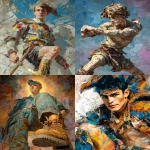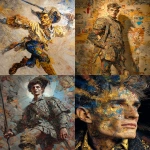Explore the Best AI Image Gallery

Beyond the Brush: How Wearable Tech is Reimagining Artistic Expression
The creative landscape is undergoing a seismic shift, fueled by the rapid advancements in wearable technology. No longer confined to traditional mediums like paintbrushes and clay, artists are now wielding sensors, haptic feedback, and immersive technologies to redefine artistic expression. From interactive installations that respond to body movements to augmented reality experiences that blend the physical and digital realms, wearable tech is empowering creators to push the boundaries of imagination.
A New Palette of Possibilities
Wearable technology offers a myriad of tools for artists to explore novel forms of creative expression:
- Motion-Sensing Garments: Imagine clothing that transforms into a canvas, reacting to the wearers movements with flowing patterns and vibrant colors. Motion sensors embedded in garments can capture gestures, body language, and even heart rate, translating these biometrics into dynamic visual displays.
- Haptic Feedback Devices: By integrating haptic feedback into artistic tools, wearables can introduce a new dimension of tactile interaction. Sculptors could feel the texture of virtual materials, musicians could experience the nuances of a simulated instrument, and dancers could interact with digital environments through physical touch.
- Augmented Reality Overlays: AR glasses or contact lenses can superimpose digital elements onto the real world, allowing artists to create interactive installations that blend seamlessly with their surroundings. Imagine walking through a cityscape where buildings transform into living canvases or murals respond to your presence.
Beyond Visual Arts: Expanding Creative Horizons
The influence of wearable tech extends far beyond visual arts, impacting a wide range of creative disciplines:
- Music Composition: Musicians can use wearable sensors to capture their body movements and translate them into musical melodies or rhythms. Imagine composing music in real-time by simply moving your hands or swaying your body.
- Interactive Storytelling: Wearables can create immersive and personalized storytelling experiences where the audiences actions influence the narrative. Imagine a theatre performance where actors react to your gestures, or a virtual reality story that adapts based on your choices.
- Collaborative Design: Wearable devices can facilitate real-time collaboration among designers, architects, and engineers. Imagine teams working together on a project, sharing ideas and visualizing designs through haptic feedback and shared augmented reality experiences.
Ethical Considerations in the Wearable Art Frontier
As with any emerging technology, the integration of wearable tech into creative practices raises important ethical considerations:
- Data Privacy: Wearables collect vast amounts of personal data, including biometric information and movement patterns. It is crucial to ensure that this data is collected and used responsibly, with transparent consent mechanisms and robust privacy safeguards.
- Accessibility and Inclusivity: Wearable art should be accessible to individuals with diverse abilities and socioeconomic backgrounds. Designers must consider the needs of all users and strive to create inclusive experiences.
- Authenticity and Ownership: The lines between human creativity and technological intervention can become blurred when using wearables. It is important to establish clear guidelines regarding authorship, intellectual property rights, and the authenticity of artistic creations.
The Future of Wearable Art: A Glimpse into Tomorrow
The future of wearable art holds immense potential for innovation and creative exploration:
- Brain-Computer Interfaces (BCIs): BCIs could enable artists to control digital environments or create artwork directly with their thoughts, blurring the lines between mind and machine.
- Personalized Art Experiences: Wearables will allow for highly personalized art experiences tailored to individual preferences, emotions, and even genetic predispositions.
- Immersive Collaborative Worlds: Imagine artists collaborating in shared virtual spaces, wearing haptic suits and interacting with digital sculptures, paintings, or musical instruments as if they were physically present.
](https://images.ai-img.art/thumbnails/150/1614d64dd7156c95db952258978be809eb3db8cea4453fec69c49cbdfe63fa94.webp)



](https://images.ai-img.art/thumbnails/150/3a60737a5b67fa252207ad1ae6db245a26284f53fb5846996bb34515b39ff269.webp)





](https://images.ai-img.art/thumbnails/150/8c3bd422d50d35735d8fb33bd314a79e30e5b150129d5d09bdad822a2007593f.webp)

